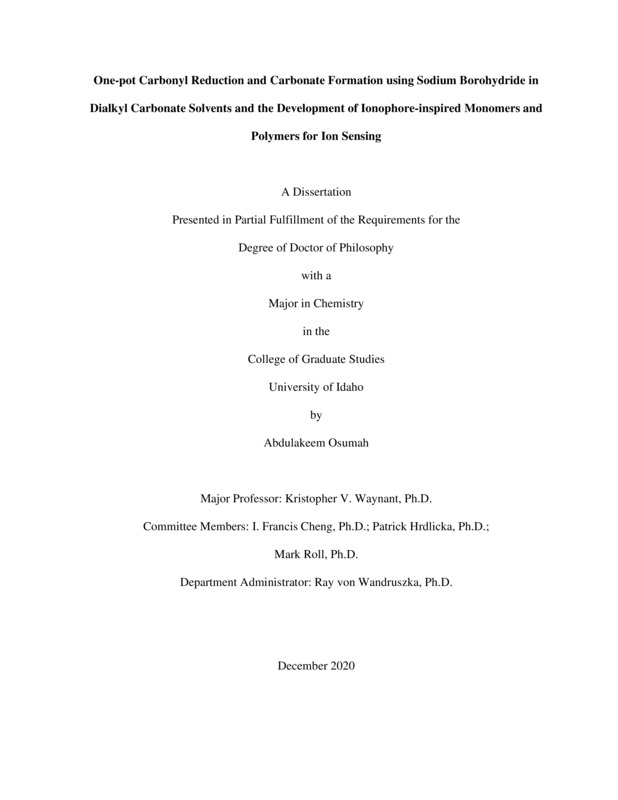One-pot Carbonyl Reduction and Carbonate Formation using Sodium Borohydride in Dialkyl Carbonate Solvents and the Development of Ionophore-inspired Monomers and Polymers for Ion Sensing
Osumah, Abdulakeem. (2020-12). One-pot Carbonyl Reduction and Carbonate Formation using Sodium Borohydride in Dialkyl Carbonate Solvents and the Development of Ionophore-inspired Monomers and Polymers for Ion Sensing. Theses and Dissertations Collection, University of Idaho Library Digital Collections. https://www.lib.uidaho.edu/digital/etd/items/osumah_idaho_0089e_11924.html
- Title:
- One-pot Carbonyl Reduction and Carbonate Formation using Sodium Borohydride in Dialkyl Carbonate Solvents and the Development of Ionophore-inspired Monomers and Polymers for Ion Sensing
- Author:
- Osumah, Abdulakeem
- ORCID:
- 0000-0002-7296-8286
- Date:
- 2020-12
- Keywords:
- calcium ion-selective electrode carbon nanotube carbonate green chemistry ionophore one-pot
- Program:
- Chemistry
- Subject Category:
- Organic chemistry; Polymer chemistry; Nanotechnology
- Abstract:
-
This dissertation describes two separate projects. First is a convenient synthetic method for the conversion of ketones and aldehydes to unsymmetrical carbonates in refluxing dialkyl carbonate solvents using sodium borohydride in a single step. This one-pot method utilizes “greener” carbonate solvents and eliminates the need for toxic alkyl chloroformate reagents. An extensive substrate scope and reaction optimization are presented. The second part describes the development of flexible and printable calcium ion-selective electrodes (ISEs) and the use of commercially available conductive CNT inks as the ion-to-electron transducer. These electrodes were evaluated potentiometrically with the aim of retaining sensitivity while also evaluating the surface impedance. We found that ionophores were compatible and equally selective when printed with conductive ink, yet the binding agents were not compatible and needed to be added separately following jet-printing. This led to the synthesis of a novel ionophore-inspired monomer and its polymerization both in various copolymer blends and in bulk on surfaces using activators regenerated by electron transfer atom transfer radical polymerization (ARGET ATRP). The polymerization blends were used to explore the potential of replacing common binding agents found in solid contact ISEs with ionophore based binding agents. The ARGET ATRP polymer brushes were developed with the goal of growing the ion-sensing polymers directly onto carbon nanotubes (CNTs) as potential ion-sensing components to known CNT inks. Ultimately, it was found that the total average bond distances of the novel ionophore analog were within 0.5% difference of that of the known calcium ionophore ETH129, yet the stoichiometry differed. Overall, ionophore compatibility in jet-printing, sensing, and the monomer as a potential polymer candidate for device design were explored.
- Description:
- doctoral, Ph.D., Chemistry -- University of Idaho - College of Graduate Studies, 2020-12
- Major Professor:
- Waynant, Kristopher V
- Committee:
- Cheng, Francis I; Hrdlicka, Patrick J; Roll, Mark
- Defense Date:
- 2020-12
- Identifier:
- Osumah_idaho_0089E_11924
- Type:
- Text
- Format Original:
- Format:
- application/pdf
- Rights:
- In Copyright - Educational Use Permitted. For more information, please contact University of Idaho Library Special Collections and Archives Department at libspec@uidaho.edu.
- Standardized Rights:
- http://rightsstatements.org/vocab/InC-EDU/1.0/

